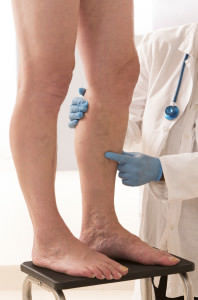
As with many disease processes being overweight is a risk factor for Chronic Venous Insufficiency or Venous Reflux Disease. Research has demonstrated that overweight women are more at risk than overweight men, although why this is the case is still unclear. Other risk factors include gender, age, family history, multiple pregnancies and standing profession.
Venous insufficiency most commonly presents as recurrent aching and unreasonable tiredness of the legs. This disease entity may also present with leg swelling. All too often these symptoms develop surreptitiously over years, so most patients may just take their presence as an integral part of aging. Commonly women and men first notice only the cosmetic presentations of venous insufficiency (spider veins or even large, ropey, worm-like veins known as varicose veins).

Varicose veins and spider veins are caused when the valves of the veins are weakened. Veins, which work against gravity as they carry blood back to the heart, contain one-way valves to prevent the blood from flowing backwards. When the valves weaken, blood collects in the vein. Pooled blood enlarges the vein. This increased pressure in the venous system leads initially to spider veins and subsequently varicose veins. The plasma from this blood pooling exudes out of the veins into the surrounding tissues making the skin look hyper pigmented (darker), ultimately leading to the formation of painful non-healing ulcers.
Early treatment is crucial to prevent the further progression and complications, hence giving credence to the fact that the treatment of venous insufficiency (varicose and spider veins) is a necessity and not a luxury. Most insurance companies recognize this necessity and now include the treatment of large varicose veins and venous insufficiency as a covered benefit.
Varicose veins are now treated with a minimally invasive in-office procedure. It takes about an hour of the patient’s time, and in most cases the patient can go back to work (if they so desire) the same day. This procedure can be performed using either radiofrequency ablation or the laser ablation of diseased varicose veins. This procedure is a welcome change from the painful vein stripping procedure which would need to be done in the hospital and would require weeks of recovery.
It is possible to love your legs again but one must take action to make this a reality. If you suffer from leg pain, swelling or varicose veins talk to your primary care doctor for a referral to a vein specialist for the proper treatment.